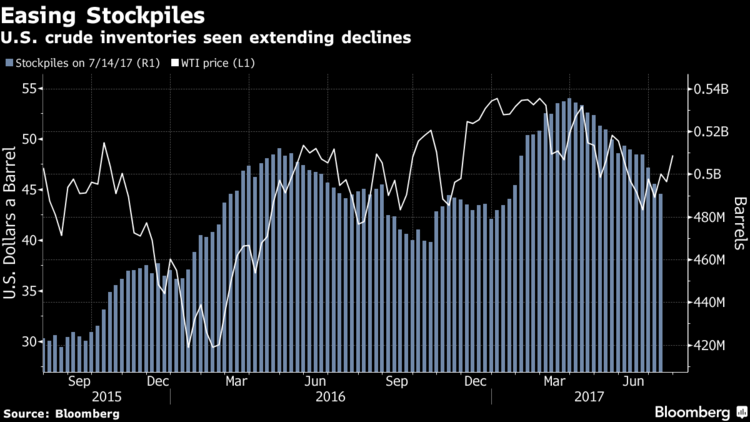
Oil extended gains from the highest close in seven weeks as industry data showed US crude stockpiles plunged, easing a glut.
Futures climbed as much as 1.4 percent in New York after rising 4.6 percent in the previous two sessions. Inventories tumbled by 10.2 million barrels last week, the American Petroleum Institute was said to report. If the decline is replicated in government data Wednesday, it would be the biggest decrease since September. The United Arab Emirates reiterated its commitment to the OPEC agreement on production cuts and said it would deepen its own curbs.
Oil has traded below $50 a barrel since May amid concern rising global output will offset reduced flows from members of the Organization of Petroleum Exporting Countries and its allies including Russia. While U.S. crude stockpiles continue to decline during a period of strong seasonal demand, nationwide inventories remain about 100 million barrels above the five-year average.
“It’s hard to estimate when the market will move into balance because so much of it depends on price,” said Michael McCarthy, a chief strategist at CMC Markets in Sydney. “Oil close to $40 would see it moving into balance fairly quickly, but a price above $50 could see increased supply across the board and the market remaining in surplus for some time.”
West Texas Intermediate for September delivery rose as much as 65 cents to $48.54 a barrel on the New York Mercantile Exchange, and was at $48.42 at 8:16 a.m. in London. Total volume traded was about 3 percent below the 100-day average. Prices gained $1.55 to $47.89 on Tuesday, the highest close since June 6.
Brent for September settlement climbed as much as 47 cents, or 0.9 percent, to $50.67 a barrel on the London-based ICE Futures Europe exchange. Prices added $1.60, or 3.3 percent, to $50.20 on Tuesday. The global benchmark traded at a premium of $2.21 to WTI.
Energy companies advanced in Asia, with the MSCI AC Asia Pacific Energy sub-index rising 1.4 percent. China Petroleum and Chemical Corp., known as Sinopec, climbed 2 percent and PetroChina Co. added 2.9 percent, while Australia’s Santos Ltd. increased as much as 5.4 percent.
U.S. gasoline stockpiles increased by 1.9 million barrels last week, the API said Tuesday, according to people familiar with the data. Crude inventories probably fell by 3 million barrels, according to the median estimate before an Energy Information Administration report Wednesday.
Oil-market news:
The Abu Dhabi National Oil Co.’s shipments of Murban, Das and Upper Zakum crudes will be 10 percent lower from September, Minister of Energy Suhail Al Mazrouei said in a tweet on Tuesday. The shale boom might be showing the first signs of slowing down, but don’t expect explorers in the Permian to run for the exits anytime soon. They’ve got protection in strong hedges.
Recommended for you
